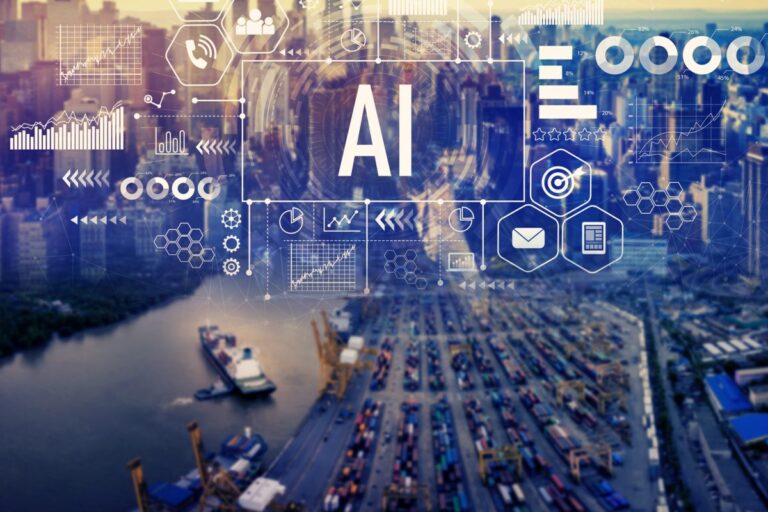AI and Logistics in the GCC
The Middle Eastern logistics sector has seen a significant upswing in recent years, primarily due to strategic geographical positioning, burgeoning e-commerce trends, and robust infrastructure development. Countries like the UAE, Saudi Arabia, Qatar, and others have become essential nodes in global trade, facilitating the movement of goods across continents. Despite this positive trajectory, there are still challenges such as operational efficiency, cost control, and timely deliveries that need addressing. This is where the advent of Artificial Intelligence (AI) presents a massive opportunity. The application of AI, in its various forms, promises to drive productivity, slash costs, and initiate a significant shift in how the logistics sector operates in the Middle East.
AI applications for logistics range from predictive analytics and autonomous vehicles to intelligent routing, smart warehousing, and customs compliance. For instance, through predictive analytics, AI can analyze historical data to anticipate demand and forecast potential disruptions, helping logistics companies optimize their inventory management and distribution channels. Autonomous vehicles, such as drones and self-driving trucks, promise round-the-clock operations, reducing errors, improving safety, and significantly enhancing the delivery process. Similarly, AI can streamline routing based on real-time data and automate various warehousing tasks, thereby reducing human error and improving overall efficiency. Additionally, AI can simplify the customs clearance process and improve supply chain visibility by enabling real-time tracking of goods. These AI-driven improvements will not only enhance operational efficiency but also contribute to environmental sustainability by reducing fuel consumption and lowering emissions.
In this piece, we’ll dissect the Middle Eastern logistics market and the possibilities AI presents to improve it.
GCC – The Regional Hub for International Trade
The GCC serves as a significant hub for international trade and business, responsible for billions of dollars worth of cargo annually passing through ports like Dubai, Abu Dhabi, and Jeddah. Despite its significance to the international economy, the Middle Eastern logistics sector has recently encountered numerous difficulties – mostly attributed to its own growth. High operational costs, intricate regulations, and ineffective supply chain procedures that cause delays in shipments are examples of the challenges.
Potential Solutions
AI offers creative solutions to these challenges, promising greater growth, efficiency, and speed to market for market players. Predictive analytics is a prime example of how AI and machine learning algorithms can increase productivity. AI is able to parse through massive amounts of data to forecast future trends and identify patterns in consumer behavior and how it manifests into supply chains. By anticipating demand, increasing forecasting precision, and requiring less manual involvement, this information can be used to streamline logistical procedures which in turn can help lower costs.
The deployment of autonomous vehicles is another way AI is being applied to enhance logistics not only in the Middle East. but throughout the entire world. Delivery robots and self-driving trucks are already being tested in a number of the region’s nations, and they have the potential to greatly cut costs and speed up deliveries. In order to manage highways and traffic, autonomous vehicles are fitted with sensors and cameras, which eliminates the need for human drivers. This can lower operational costs, promote safety, and speed up and improve delivery times.
In addition to these uses, AI can also be utilized to improve asset utilization and streamline logistics processes by lowering downtime. To reduce the possibility of unplanned downtime and increase overall equipment efficiency, AI-powered predictive maintenance algorithms can be used, for instance, to monitor equipment and forecast when repair is necessary.
Obstacles to Implementing AI in Logistics
Although AI offers many advantages for the logistics sector, there are still some obstacles that must be removed in order for it to reach its full potential. The requirement for qualified staff to run and maintain AI systems is one of the largest obstacles.
The high expense of implementing AI systems is another difficulty. Companies must spend on infrastructure and training in order to ensure that AI systems are deployed successfully, as the initial investment in AI technology can be substantial. However, over time, these initial expenses may be more than offset by the long-term advantages of AI, such as decreased costs and increased efficiency.
To fully exploit the advantages of AI in the logistics business, there is a need for industry actors to work together. To develop and adopt AI solutions that can be applied throughout the whole supply chain, from procurement to delivery, businesses must collaborate. This necessitates a common vision and a readiness to make the necessary investments in infrastructure, staff, and technology.
Conclusion
Indeed, the potential of AI to revolutionize the GCC logistics sector is immense. By harnessing this advanced technology, the sector can expect to see substantial improvements in productivity, efficiency, and cost-effectiveness. The predictive capabilities of AI can facilitate better demand forecasting and risk management, allowing companies to optimize inventory and mitigate potential supply chain disruptions. Simultaneously, AI-powered autonomous vehicles can revolutionize transport, enabling round-the-clock operations, reducing errors, and enhancing safety and speed in the delivery process. This represents a significant shift towards a more resilient, agile, and cost-efficient logistics framework in the GCC region.
In addition to these advancements, AI is paving the way for more innovative transformations such as smart warehousing, intelligent routing, improved customs compliance, and enhanced supply chain visibility. These applications not only streamline operations but also contribute to sustainability goals by reducing fuel consumption and emissions. For instance, AI can automate warehouse tasks and optimize routing, reducing the need for manual intervention and, consequently, the risk of human error. Similarly, AI can simplify and expedite the customs clearance process, minimizing delays and enhancing trade facilitation. Thus, the integration of AI within the GCC logistics sector is not just about cost reduction and efficiency; it’s also about building a more sustainable and resilient logistics infrastructure that can adapt and thrive amidst evolving global trade dynamics.





